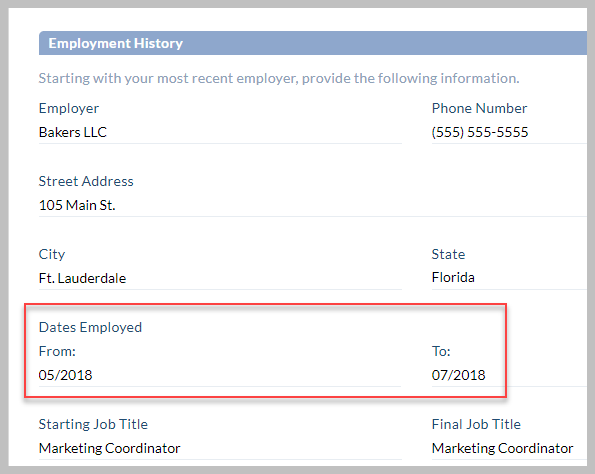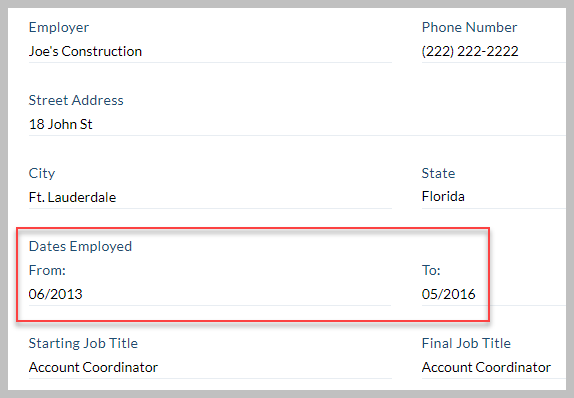When hiring, you want to use all the tools at your disposal to get an accurate picture of whether a candidate is a good fit or not. That may include asking for a resume and cover letter, having the candidate fill out a job application, conducting phone interviews, holding in-person meetings and calling back the best candidates for additional interviews or pre-employment testing.
Throughout the entire process, you’re looking for signs the candidate has the skills, experience and aptitude to succeed at your company. At the same time, you’re tuning into red flags that could indicate potential problems. Here are a few to be aware of:
Large gaps in employment
An employment gap on a candidate’s job application doesn’t have to be a deal-breaker, but it could be a concern (especially if there is more than one gap). Functional resumes without dates — or resumes that list only years but not months of employment — can also hide chronological details. However, there are many valid reasons for job gaps. Don’t discount an otherwise strong resume just because a candidate has a period of unemployment. Would you bypass a potential star employee because he or she chose to go back to school (or had trouble finding the right job after getting laid off during a recession)? The best candidates will explain any gaps in their resume or job application, so always give them the chance to do so.


Spelling or grammar mistakes
Spelling or grammar errors on a resume or job application could signal a tendency toward sloppy work. After all, candidates should be putting their best foot forward and trying to make a good impression. Carelessness on a job application could also be a warning of what you can expect from the candidate in the future. Put this one at the bottom of the list.

Lacking attention to detail
Similarly, if a candidate submits an incomplete application or puts the wrong information in a field, it indicates a lack of attention to detail. That could mean the applicant didn’t take the time to carefully review the application before submitting it. Including fillers (such as “xxx”) in place of requested information, such as dates or achievements, indicates haste or carelessness as well.

Not following directions
Failing to follow directions is a major red flag. An applicant who doesn’t read your instructions or meet your requests may not be reliable in completing tasks on the job either. For example, if the applicant doesn’t submit a salary history, cover letter and resume as requested, it could be a warning sign. (Keep in mind, however, that a number of cities and states now have laws restricting employers from asking about salary history. Be sure to update your application form and hiring process, if necessary, to avoid over-stepping your legal boundaries.)
Is your request for salary history legal? In some states, no. Seven states ban salary history questions for all employers (public and private): CA, CT, DE, HI, MA, OR and VT. In four states, the ban applies only to public employers: IL, NJ, NY and PA (as well as Puerto Rico).
Lies or inconsistencies
Watch for signs that a candidate submitted false or misleading information on the job application. It’s not uncommon for job seekers to embellish their skills or credentials on their resumes. Some go so far as to make up academic degrees or fabricate job titles. In fact, one survey published by Inc. stated that 85 percent of employers have caught someone lying on a resume. Such inconsistencies may be obvious if dates and titles don’t match what the candidate posted on LinkedIn.
Vague answers
Giving general descriptions of past jobs or not listing accomplishments could indicate weak skills or a poor performance history. Likewise, overly wordy descriptions of past jobs that read like laundry lists of daily routines, rather than key achievements, shows the applicant doesn’t understand what’s relevant to your available position. Look for applicants who provide targeted, thoughtful responses.
No upward mobility
An application that shows years of experience, but little evidence of increasing responsibility, could be a no-no. When reading an applicant’s description of past job duties, look for strong words that show a sense of accountability. For example, words like “led,” “managed,” “created,” “implemented” or “ran” are signs of an employee who took initiative in previous roles.


Tactics to Identify Inconsistencies
Using a clean, consistent application form with every candidate is necessary for spotting red flags. The Job Application Smart App captures the same information from all candidates, so you can compare responses and quickly identify inconsistencies. For example, you can assess work history over time to pinpoint gaps and track signs of advancement. Plus, the attorney-developed online application only contains legally permitted questions, so you can be confident you’re in compliance with the most current hiring laws for your state.

(According to a Harris Poll Survey)
- The percentage of employees using social media to screen candidates today is 70%. (Up from 11% in 2006)
- Half of employers (54%) didn’t hire a candidate because of content found online.
- On the other hand, 44% of employers have hired employees because of content found on social networking sites.
- For effective hiring, always be on the lookout for red flags indicating lack of skills, experience or aptitude
- Gaps in employment aren’t a deal breaker but should be explored
- Typos, grammar errors and missing information demonstrate lack of attention to detail
- Vague answers, inconsistencies and lies can be a major concern
- The Job Application Smart App includes a database of compliant questions to guide your hiring process






